Business Architecture Tools of the Trade
By: Ciopages Staff Writer
Updated on: Feb 25, 2023
In this post, let’s examine the business architecture tools, templates, frameworks, and models – the tools of the trade of a business architect. As we all know, business architecture when done right can be a useful catalyst for business/IT alignment and optimal technology enablement. The business architecture tools span the spectrum based role definition of the business architect on the intent and the content of the business architecture deliverables.
Business Architecture Tools of the Trade:
Strategy Interpretation Tools:
While the business architect may or may not contribute to the company’s strategy and operating model, understanding, and deciphering the strategy within the context of the business architecture and presenting it concisely and coherently is a vital function.
Value Chain:
The value chain is a seminal concept initially proposed by Michael Porter, a management theorist, and a professor at Harvard Business School. Understanding the value chain of a firm helps in figuring out where companies generate the “Value” or the “Margin” and what activities are involved in this process and their interlinkages.
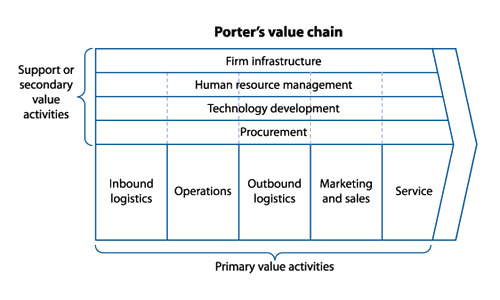
How is Porter’s value chain useful as an integral part of business architect tools? Business architects can use Porter’s value chain as a way to model the essence of business activities and value creation. Furthermore, a well-constructed value chain could become the Level 0 of an enterprise business capability model. The value chain allows business architecture practitioners to use a paradigm that the senior business leadership is comfortable with and has used in the corporate strategy development context.
Business Model:
At its elemental level, a Business model is how a business intends to make money. There are many ways to depict a business model, but one tool that has caught the imagination of entrepreneurs and executives alike is Alexander Osterwalder’s Business Model Canvas. Business model canvas is elegant and simple at its core, but one can derive deep meaning by focusing on the critical parts of the business model and the associated entities that support and enhance the model.
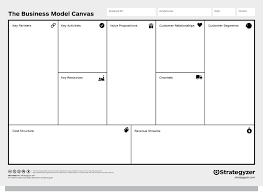
Strategy Map:
Robert Kaplan and David Norton, of the Balanced Scorecard fame, have proposed a concept called Strategy Maps to document enterprise strategy into a visually rich paradigm.
Kaplan and Norton note, “Strategy maps can depict objectives for revenue growth; targeted customer markets in which profitable growth will occur; value propositions that will lead to customers doing more business and at higher margins; the key role of innovation and excellence in products, services, and processes; and the investments required in people and systems to generate and sustain the projected growth.”
The strategy map offers a valuable tool to interlink various perspectives and provides a way to define, disseminate, and track the strategy development process.
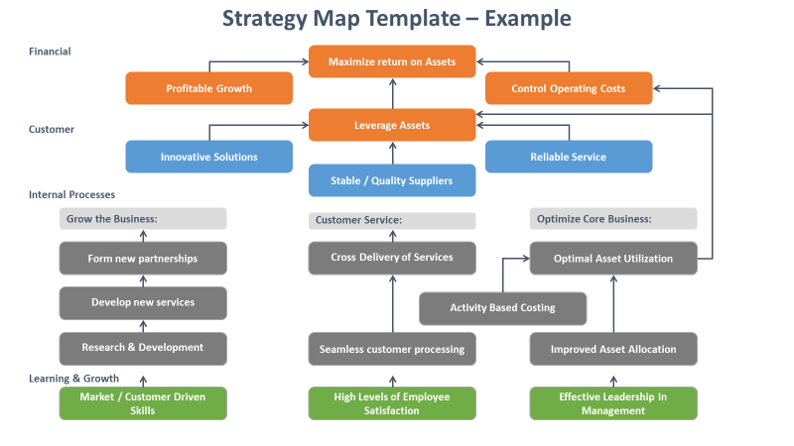
According to Wikipedia:
“The strategy map is a device that promotes three stages of conversation during the strategy development, implementation and learning process
-
First to capture a strategy from a management team. To promote discussion amongst that team on the strategy, so they all leave the room telling the same story of their strategy.
-
Secondly to communicate the strategy, focus organization efforts, and choose appropriate measures to report on an organization’s progress in implementing a strategy.
-
Finally to provide a basis to review and potentially revise the strategy, (not simply the measures or targets) and support conversations and decision making, as the team learns from the strategy’s implementation.”
Enterprise Business Motivation Model:
Business Rules group initially proposed the business motivation model. Nick Malik, a well-known enterprise architect, has also created a business motivation model.
At the core business motivation model aims to capture why business is doing what it is doing, how does it intend to it, and what will take to get to the destination, and how to measure the progress along the way.
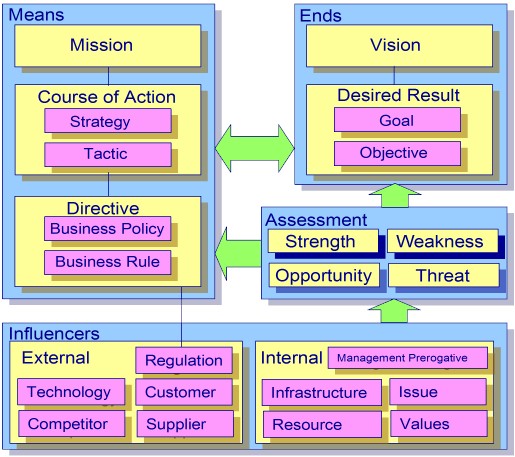
Business Architecture Elements:
Business Capability Model:
A business capability model is an encapsulation of what a business does and can do. A business capability is the cornerstone of business architecture and an elemental building block. Business capability maps are useful for strategic, conceptual, operational, and IT enablement needs.
Depending on the purpose, one can define the business capability model for the entire company, or start at the level of a business unit or a functional area. The ideal scenario is an enterprise model, but sometimes it is difficult to boil the ocean – particularly in large firms with complex structures that are geographically spread out.
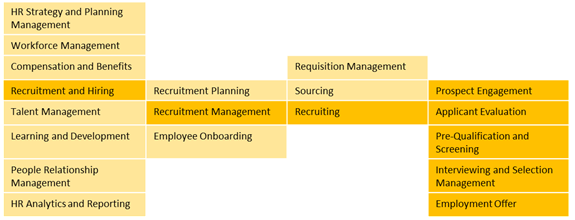
Building a business capability map is a non-trivial task, mainly if the intent is to capture the core essence of the firm and conform to the constructs of MECE (Mutually Exclusive, Collectively Exhaustive). Starting from a customizable business capabilities models might jumpstart the endeavor.
Value Streams:
Value Streams are typically an end-to-end stakeholder perspective of a set of activities flow to consummate a business outcome. Value streams are an integral part of the business architecture tools, particularly to represent the “How” which supplements and complements the capabilities construct, the “What.”
Below is a simple example of a classic value stream depicted here from the perspective of a customer:

If you wish to learn about the essential value streams in a typical manufacturing outfit, please check out Ralph Whittle’s sample case study.
One can supplement and delve deeper into the value streams by mapping value stream stages/steps to underlying process flow charts. It will be a many to many relationships between value streams and process maps.
Business Information Model:
A Business Information Model or a Business Entity Model is a high-level compilation of the data set relevant from a business point of view. If it exists, the business information model can be input to the data architects modeling the conceptual, logical, and physical data models. If it is not present, the data architecture team may strip some of the details and provide a simple entity list.
Application and Systems List:
One of the critical values of business architecture is the ability to show the footprint of applications/systems which power the capabilities. Hence, while a business architect is not the person accountable or responsible, he or she must work with the IT team to get the latest inventory of systems (which is typically a part of ITAM (IT Asset Management) software). In addition to the name, description, it would help if there is an assessment of the applications with regards to their functional factors, cost factors, and architecture considerations.
Requirements/Backlog:
A business architect should collect a list of crucial feature requests, requirements, and changes to align them to a capability set, thus generating a capability-centric transformation roadmap. A capability-based transformation roadmap is one of the critical business architecture tools for bridging the gap between structural and operational, strategic and the execution pieces.
| Capstera Capability Modeling and Business Architecture Software |
|---|
| If you are looking for an easy to use and comprehensive platform for modeling your business capabilities and building a business architecture blueprint, Capstera is your solution. Visit https://www.capstera.com |
Business Architecture Views, Lenses, and Viewpoints:
Target Operating Model:
Target operating model is a blueprint of the future state with regards to business model, strategy, structure, processes, systems, and roles.
Strategy-to-Capability Mapping:
Capabilities are the glue that holds the strategic intent with operational purpose. Mapping which capabilities are necessary to achieve the stated corporate strategy is a high value endeavor. It involves simple mapping of which capabilities drive the strategy and to what extent/magnitude. Any capabilities that are core to the successful implementation of a strategy must be considered core.
Capability to Applications:
A business architect facilitates the mapping of applications/systems to capabilities. This mapping provides a view of the footprint of which capabilities are related to what applications and which applications power and to what extent of various capabilities. These relationships are a many-to-many matrix.
Capabilities-to-Products/Services:
The concept of mapping capabilities to products/services is similar in intent to the capability-to-applications as mentioned above. The goal is to understand what are the underlying capabilities of various products, platforms, services. Understanding this provides clarity and transparency of elemental capabilities which are universal and which are exclusive to each product and service.
Capabilities-to-SOA/Micro Services:
The capabilities-SOA/Micro Services is similar to the application mapping paradigm. The only difference is instead of coarse grain applications; here you are mapping micro and mini services. Conceptually, a cluster of capabilities is a business service, and an IT service is a corollary on the technology side.
Capabilities-based Transformation Roadmap:
A capabilities-based transformation roadmap is the holy grail of business architecture tools, templates, techniques, and methods. The transformation roadmap is a summary view of what changes are necessary to evolve the capabilities to meet future needs of the business.
Capability-based Budget Allocations:
One of the challenges in measuring the value of IT from a business perspective is how companies develop, deploy, and manage IT assets. A capability-based budget sheds transparency into the money spent at a capability-level. For example, should you spend millions of dollars on a capability that is low on strategic importance and is a commodity? On the other hand, if the stated strategy requires investment into particular capabilities, the capability-based budget allocation clearly will demonstrate whether or not a company is putting the money where its mouth is.
As a business architect, what other business architecture tools, techniques, templates, models, and methods do you use?
Customizable Capability Models:
-
Human Resources Capabilities Model
U.S. $699 – U.S. $1,999Category : Capability Models
View Product This product has multiple variants. The options may be chosen on the product page -
Supply Chain Capabilities Model
U.S. $699 – U.S. $1,999Category : Capability Models
View Product This product has multiple variants. The options may be chosen on the product page -
Marketing Capabilities Model: List of marketing capabilities
U.S. $699 – U.S. $1,999Category : Capability Models
View Product This product has multiple variants. The options may be chosen on the product page -
Customer Management Capabilities Model
U.S. $699 – U.S. $1,999Category : Capability Models
View Product This product has multiple variants. The options may be chosen on the product page -
Finance Capability Model
U.S. $699 – U.S. $1,999Category : Capability Models
View Product This product has multiple variants. The options may be chosen on the product page -
CRM Capabilities Model: A matrix of customer relationship capabilities
U.S. $699 – U.S. $1,999Category : Capability Models
View Product This product has multiple variants. The options may be chosen on the product page -
Business Intelligence Capabilities Model: BI Capabilities
U.S. $599 – U.S. $1,499Category : Capability Models
View Product This product has multiple variants. The options may be chosen on the product page